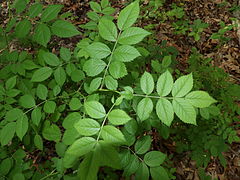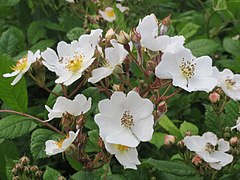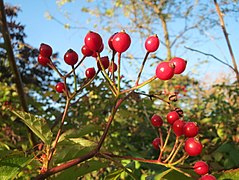Rosa multiflora
| Rosa multiflora | |
|---|---|

| |
| Scientific classification | |
| Kingdom: | Plantae |
| Clade: | Tracheophytes |
| Clade: | Angiosperms |
| Clade: | Eudicots |
| Clade: | Rosids |
| Order: | Rosales |
| Family: | Rosaceae |
| Genus: | Rosa |
| Species: | R. multiflora
|
| Binomial name | |
| Rosa multiflora | |
| Synonyms[1] | |
| |
Rosa multiflora (syn. Rosa polyantha)[2] is a species of rose known commonly as multiflora rose,[3] baby rose,[3] Japanese rose,[3] many-flowered rose,[3] seven-sisters rose,[3] Eijitsu rose and rambler rose. It is native to eastern Asia, in China, Japan, and Korea. It should not be confused with Rosa rugosa, which is also known as "Japanese rose", or with polyantha roses which are garden cultivars derived from hybrids of R. multiflora. It was introduced to North America, where it is regarded as an invasive species.
Description
[edit]It is a scrambling shrub climbing over other plants to a height of 3–5 m (9 ft 10 in – 16 ft 5 in), with stout stems with recurved prickles (sometimes absent). The leaves are 5–10 cm (2–4 in) long, compound, with 5–9 leaflets and feathered stipules. The flowers are produced in large corymbs, each flower small, 1.5–4 cm (5⁄8–1+5⁄8 in) diameter, white or pink, borne in early summer. The hips are reddish to purple, 6–8 mm (15⁄64–5⁄16 in) diameter.
Plants of the World Online and Flora of China[4] include the varieties:
- Rosa multiflora var. adenochaeta (Koidz.) Ohwi
- Rosa multiflora var. cathayensis Rehder & E.H.Wilson. Flowers pink, to 4 cm (1+5⁄8 in) diameter.
- Rosa multiflora var. multiflora. Flowers white, 1.5–2 cm (5⁄8–3⁄4 in) diameter.
Cultivation and uses
[edit]Rosa multiflora is grown as an ornamental plant and also used as a rootstock for grafted ornamental rose cultivars.
In eastern North America, Rosa multiflora is considered an invasive species. It was originally introduced from Asia as a soil conservation measure, as a natural hedge to border grazing land, and to attract wildlife. It is readily distinguished from American native roses by its large inflorescences, which bear multiple flowers and hips, often more than a dozen, while the American species bear only one or a few on a branch.[citation needed]
In some regions the plant is classified as a noxious weed.[5] In grazing areas, it is generally considered to be a serious pest, though it is considered excellent fodder for goats. [citation needed]
In Japan, the achene fruits of Rosa multiflora (referred to as "Eijitsu" or "Rosae fructus") has been utilized all over the world in traditional medicine historically and clinical practices to treat constipation.[6] The hips of the plant are edible and can be used to make tea or medicine.[7]
Management
[edit]The targeted removal of multiflora rose often requires an aggressive technique, such as the full removal of the plant in addition to the root structure. Pruning and cutting back of the plant often leads to re-sprouting. Two natural biological controls include the rose rosette disease and the rose seed chalid (Megastigmus aculeastus var. nigroflavus).[8] Patches of introduced multiflora rose in Pennsylvania are displaying symptoms of rose rosette disease, which can lead to decline and death.[9]
Gallery
[edit]-
Hips (fruits)
-
var. cathayensis
References
[edit]- ^ "Rosa multiflora Thunb.". Royal Botanic Gardens Edinburgh. Retrieved April 27, 2014 – via The Plant List. Note that this website has been superseded by World Flora Online
- ^ Roger Phillips; Martyn Rix (2004). The Ultimate Guide to Roses. Pan Macmillan Ltd. p. 262. ISBN 1-4050-4920-0.
- ^ a b c d e "Rosa multiflora". Germplasm Resources Information Network. Agricultural Research Service, United States Department of Agriculture. Retrieved December 15, 2017.
- ^ Gu, Cuizhi; Robertson, Kenneth R. "Rosa multiflora". Flora of China. Vol. 9 – via eFloras.org, Missouri Botanical Garden, St. Louis, MO & Harvard University Herbaria, Cambridge, MA.
- ^ Carole Bergmann; Jil M. Swearingen. "Multiflora Rose". U.S. National Park Service. Archived from the original on April 4, 2006. Retrieved March 27, 2006.
- ^ Kitahiro, Yumi; Ikeda, Hiroshi; Im, Hyoung-Tak; Kodaira, Eiichi; Shibano, Makio (June 1, 2019). "Phytochemical characterization of Rosa multiflora Thunb. (Rosaceae) in Japan and South Korea, with a focus on the bioactive flavonol glycoside 'multiflorin A'". Journal of Natural Medicines. 73 (3): 555–565. doi:10.1007/s11418-019-01302-x. ISSN 1861-0293.
- ^ "Multiflora Rose, An Invasive But Nutritious Wild Edible". Eat the Planet. February 21, 2014.
- ^ "Multiflora Rose Control". Missouri Department of Conservation. Retrieved September 14, 2024.
- ^ "Multiflora Rose: The Mixed Blessings of Rose Rosette Disease". Retrieved March 19, 2016.
External links
[edit]- Species Profile – Multiflora Rose, National Invasive Species Information Center, United States National Agricultural Library. Lists general information and resources for Multiflora Rose.







